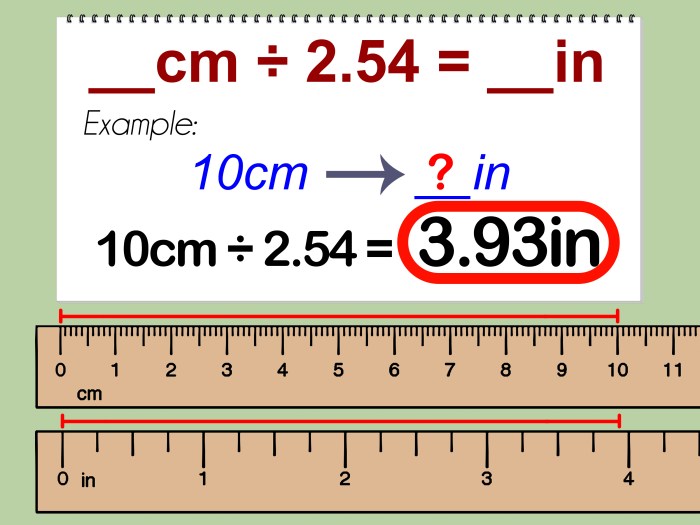Inches to cm: Embark on a journey of converting length measurements with ease and precision. Delve into the intricacies of different units, explore practical applications, and discover invaluable resources to simplify your conversion tasks.
Unravel the relationship between inches and cm, gaining a deeper understanding of the metric system. Learn about the tools that empower accurate measurements and the industries that rely on precise conversions. Prepare to navigate the world of length measurements with confidence and expertise.
Inches to cm conversions

Inches and centimeters are two common units of length used worldwide. Understanding how to convert between these units is essential in various fields, including engineering, construction, and everyday life. This guide will provide a detailed explanation of the conversion process, along with practical examples and a conversion table for your convenience.
Conversion Formula
The formula for converting inches to centimeters is:
inches x 2.54 = centimeters
To convert inches to centimeters, simply multiply the inch value by 2.54. This factor represents the number of centimeters in an inch.
Conversion Table
Here is a table showing the conversion factors for different inch values:
| Inches | Centimeters |
|---|---|
| 1 | 2.54 |
| 2 | 5.08 |
| 3 | 7.62 |
| 4 | 10.16 |
| 5 | 12.70 |
Real-World Scenarios, Inches to cm
Inches to cm conversions are necessary in various real-world scenarios, such as:
- Reading and interpreting blueprints in construction and engineering
- Converting measurements on clothing labels or patterns for sewing projects
- Comparing product dimensions when shopping online or in stores
- Measuring the height of people or objects for medical or scientific purposes
Units of measurement
Units of measurement are standards used to quantify physical quantities such as length, mass, and time. They provide a common reference point for comparing and expressing measurements.
In the realm of home furnishings, where precision matters, knowing how to convert inches to centimeters is essential. Whether you’re comparing measurements for a new couch from Harvey Norman or designing your dream kitchen, this conversion is crucial. One inch, the familiar unit of measurement, equates to approximately 2.54 centimeters, a metric unit widely used in many parts of the world.
Understanding this conversion allows you to make informed decisions when navigating the world of home decor and ensuring your furnishings fit perfectly in your desired space.
Units of length
Length is a fundamental physical quantity that measures the distance between two points. Various units of length are used worldwide, including inches and centimeters.
For those wondering about the conversion, 1 inch is equivalent to 2.54 centimeters. This comes in handy when measuring the dimensions of various objects, such as the king single bed size. Measuring king single bed size in centimeters ensures a precise understanding of its dimensions, making it easier to plan bedroom layouts and choose appropriate bedding.
The inch(in) is a unit of length in the imperial system, primarily used in the United States, the United Kingdom, and Canada. It is defined as 1/12 of a foot.
The centimeter(cm) is a unit of length in the metric system, used in most countries worldwide. It is defined as 1/100 of a meter.
The relationship between inches and centimeters is given by the conversion factor:
inch = 2.54 centimeters
This means that 1 inch is equivalent to 2.54 centimeters, and vice versa.
Conversion table
The following table summarizes the different units of length and their conversion factors:
| Unit | Abbreviation | Conversion factor |
|---|---|---|
| Meter | m | 1 |
| Centimeter | cm | 0.01 |
| Millimeter | mm | 0.001 |
| Inch | in | 0.0254 |
| Foot | ft | 0.3048 |
| Yard | yd | 0.9144 |
| Mile | mi | 1609.34 |
Measurement tools

Measuring length is a fundamental task in many fields, from engineering and construction to woodworking and sewing. There are a variety of tools that can be used to measure length, each with its own advantages and disadvantages. The most common measurement tools include rulers, measuring tapes, and calipers.
Rulers
Rulers are simple and inexpensive tools that are commonly used for measuring short lengths. They are typically made of wood, metal, or plastic and have a scale marked in inches or centimeters. To use a ruler, simply align the zero mark with one end of the object you are measuring and read the measurement at the other end.
Measuring tapes
Measuring tapes are similar to rulers, but they are longer and more flexible. They are typically made of a thin metal or fiberglass ribbon that is marked with a scale. Measuring tapes are ideal for measuring long lengths or curved surfaces.
To use a measuring tape, hold the zero mark at one end of the object you are measuring and extend the tape until it reaches the other end. Read the measurement at the point where the tape meets the object.
Calipers
Calipers are precision instruments that are used to measure the thickness or diameter of objects. There are two main types of calipers: vernier calipers and dial calipers. Vernier calipers have a sliding scale that allows you to read measurements to the nearest 0.01 millimeter.
Dial calipers have a dial that indicates the measurement to the nearest 0.01 millimeter. To use calipers, simply open the jaws of the caliper and place the object you are measuring between the jaws. Close the jaws until they gently touch the object, and then read the measurement on the scale or dial.
Choosing the right measurement tool
The best measurement tool for the job will depend on the specific application. For short lengths, a ruler is usually the best choice. For longer lengths or curved surfaces, a measuring tape is a better option. For precise measurements of thickness or diameter, calipers are the best choice.
Applications of inches to cm conversions

Inches to cm conversions are crucial in various industries and applications, ensuring accurate measurements and preventing errors. These conversions are essential in manufacturing, engineering, healthcare, and everyday life.
Manufacturing and Engineering
- In manufacturing, precise measurements are vital for designing and producing components. Incorrect conversions can lead to misalignment, improper fit, and malfunctioning equipment.
- In engineering, accurate conversions are essential for designing buildings, bridges, and other structures. Errors in conversions can compromise structural integrity and safety.
Healthcare
- In healthcare, accurate conversions are critical for administering medications and monitoring patient progress. Incorrect conversions can lead to incorrect dosages and potentially life-threatening errors.
- Medical devices, such as syringes and IV bags, are often labeled in both inches and cm. Accurate conversions ensure proper administration and dosage.
Everyday Life
- In everyday life, inches to cm conversions are used for various purposes, such as measuring clothing, furniture, and distances. Accurate conversions ensure proper fit, compatibility, and accurate measurements.
- When traveling internationally, understanding the metric system is essential. Inches to cm conversions help individuals navigate distances, purchase items, and communicate effectively.
Conversion resources
Various online resources and tools are available to facilitate inches to cm conversions with ease and accuracy. These resources offer a range of features and benefits, catering to different user needs and preferences.
Measuring in inches is a common practice in some regions, but when it comes to snuggling under a cozy flannelette quilt cover , centimeters provide a more precise understanding of the warmth and comfort it offers. Whether you prefer a single or double bed, knowing the dimensions in both inches and centimeters ensures a perfect fit for a restful night’s sleep.
By leveraging these tools effectively, you can save time and effort, ensuring precise conversions for various applications.
Online conversion websites
- ConvertWorld: A comprehensive website that provides instant conversions for a wide range of units, including inches to cm. It features a user-friendly interface and allows you to specify the number of decimal places for the result.
- RapidTables: Offers a dedicated page for inches to cm conversions. It includes a detailed table with conversion values for various inch measurements, making it convenient for quick reference.
- Calculator.net: Provides a simple and straightforward inches to cm converter. It displays the result in both centimeters and millimeters, ensuring accuracy for different applications.
Mobile applications
- Unit Converter Pro: A feature-rich mobile app that supports inches to cm conversions, along with numerous other units. It offers a user-friendly interface and allows you to save frequently used conversions for quick access.
- Convert Units: A comprehensive app that provides a dedicated section for inches to cm conversions. It features a history function, enabling you to track your previous conversions for future reference.
Browser extensions
- Unit Converter: A convenient browser extension that allows you to convert inches to cm directly from your browser. It integrates with the context menu, providing quick and easy access to conversions.
- Convert Units Plus: Another useful browser extension that offers a wide range of conversion options, including inches to cm. It displays the result in a pop-up window, making it easily accessible.
Final Review
In the realm of length measurements, the conversion from inches to cm stands as a cornerstone of accuracy and precision. Through this comprehensive guide, you have gained the knowledge and tools to confidently tackle any conversion challenge. Remember, understanding the relationship between different units and utilizing the appropriate resources empowers you to make informed decisions and achieve impeccable results.
FAQ Guide
What is the formula for converting inches to cm?
To convert inches to cm, multiply the inch value by 2.54.
How do I use a ruler to measure in cm?
Align the 0 cm mark of the ruler with the starting point of your measurement. Read the measurement at the point where the desired length ends.
What are some examples of industries that use inches to cm conversions?
Industries such as construction, engineering, and manufacturing heavily rely on accurate inches to cm conversions for precise measurements and calculations.



Leave a Comment